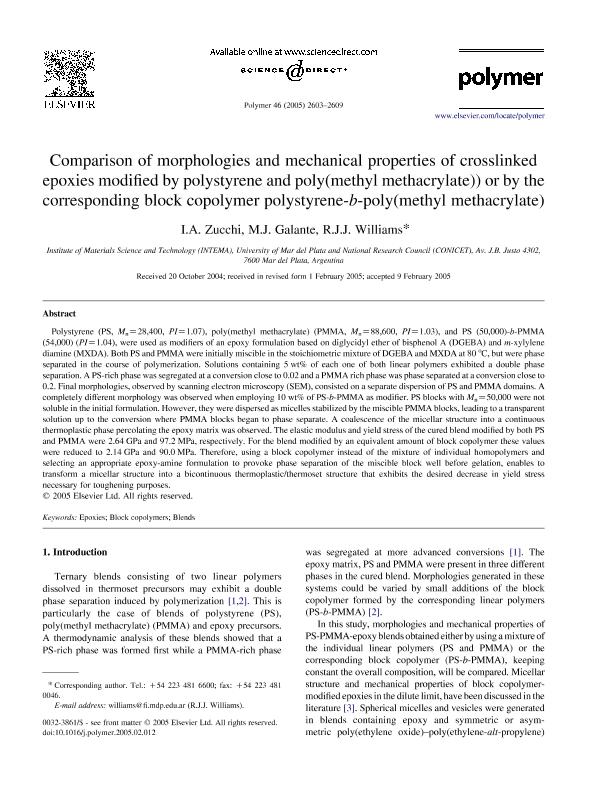Artículo
Comparison of morphologies and mechanical properties of crosslinked epoxies modified by polystyrene and poly(methyl methacrylate)) or by the corresponding block copolymer polystyrene-b-poly(methyl methacrylate)
Fecha de publicación:
03/2005
Editorial:
Elsevier
Revista:
Polymer
ISSN:
0032-3861
Idioma:
Inglés
Tipo de recurso:
Artículo publicado
Clasificación temática:
Resumen
Polystyrene (PS, Mn=28,400, PI=1.07), poly(methyl methacrylate) (PMMA, Mn=88,600, PI=1.03), and PS (50,000)-b-PMMA (54,000) (PI=1.04), were used as modifiers of an epoxy formulation based on diglycidyl ether of bisphenol A (DGEBA) and m-xylylene diamine (MXDA). Both PS and PMMA were initially miscible in the stoichiometric mixture of DGEBA and MXDA at 80°C, but were phase separated in the course of polymerization. Solutions containing 5 wt% of each one of both linear polymers exhibited a double phase separation. A PS-rich phase was segregated at a conversion close to 0.02 and a PMMA rich phase was phase separated at a conversion close to 0.2. Final morphologies, observed by scanning electron microscopy (SEM), consisted on a separate dispersion of PS and PMMA domains. A completely different morphology was observed when employing 10 wt% of PS-b-PMMA as modifier. PS blocks with Mn=50,000 were not soluble in the initial formulation. However, they were dispersed as micelles stabilized by the miscible PMMA blocks, leading to a transparent solution up to the conversion where PMMA blocks began to phase separate. A coalescence of the micellar structure into a continuous thermoplastic phase percolating the epoxy matrix was observed. The elastic modulus and yield stress of the cured blend modified by both PS and PMMA were 2.64 GPa and 97.2 MPa, respectively. For the blend modified by an equivalent amount of block copolymer these values were reduced to 2.14 GPa and 90.0 MPa. Therefore, using a block copolymer instead of the mixture of individual homopolymers and selecting an appropriate epoxy-amine formulation to provoke phase separation of the miscible block well before gelation, enables to transform a micellar structure into a bicontinuous thermoplastic/thermoset structure that exhibits the desired decrease in yield stress necessary for toughening purposes.
Palabras clave:
Blends
,
Block Copolymers
,
Epoxies
Archivos asociados
Licencia
Identificadores
Colecciones
Articulos(INTEMA)
Articulos de INST.DE INV.EN CIENCIA Y TECNOL.MATERIALES (I)
Articulos de INST.DE INV.EN CIENCIA Y TECNOL.MATERIALES (I)
Citación
Zucchi, Ileana Alicia; Galante, Maria Jose; Williams, Roberto Juan Jose; Comparison of morphologies and mechanical properties of crosslinked epoxies modified by polystyrene and poly(methyl methacrylate)) or by the corresponding block copolymer polystyrene-b-poly(methyl methacrylate); Elsevier; Polymer; 46; 8; 3-2005; 2603-2609
Compartir
Altmétricas




